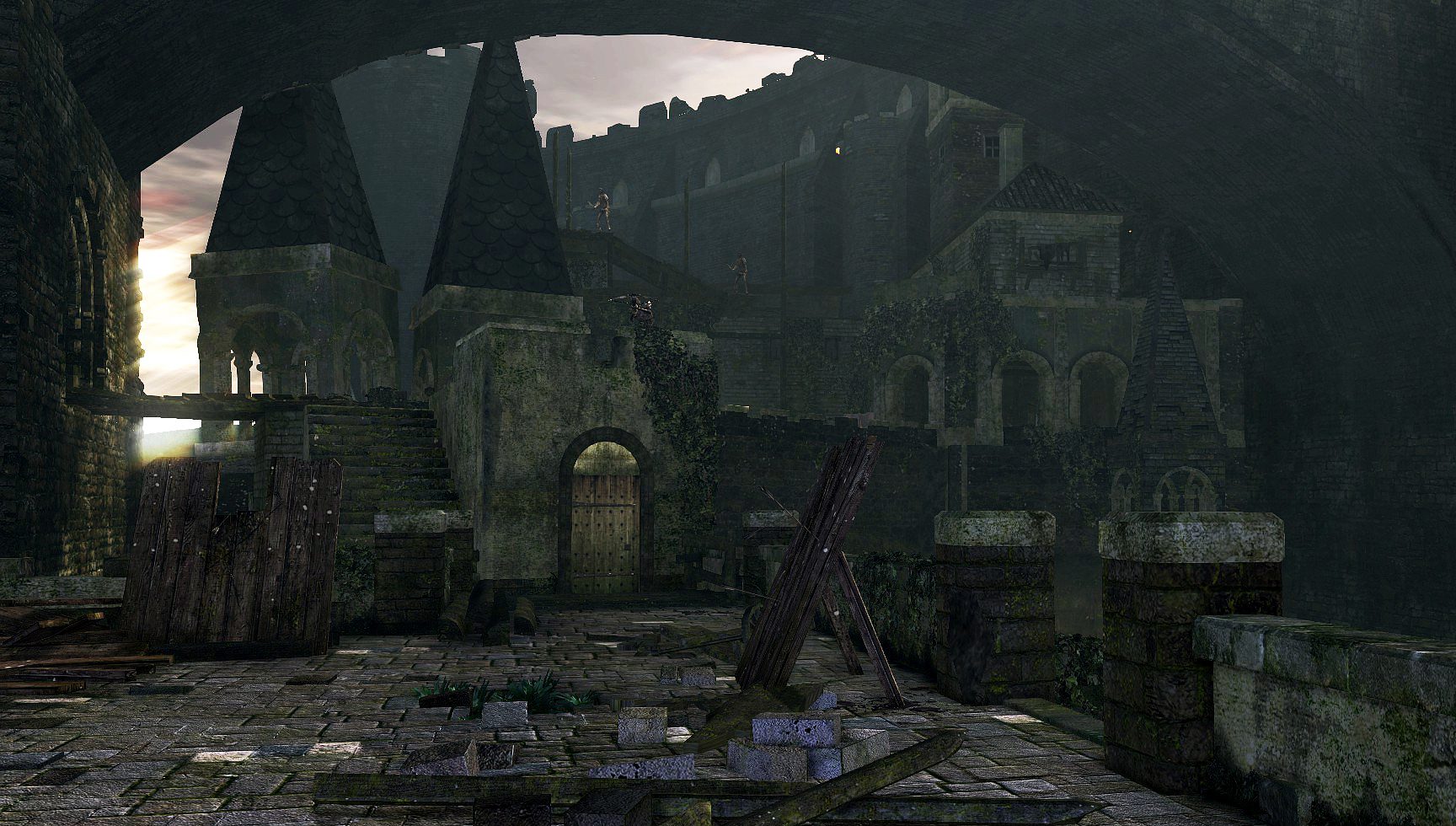The Influence and Legacy of Dark Souls – Part 1
History and Context
With the release of the highly anticipated fantasy action RPG Elden Ring only weeks away, there’s bound to be plenty of gamers and non-gamers alike unfamiliar with FromSoftware’s rich history of atmospherically challenging games. So, while patiently waiting for the launch of Elden Ring, here’s some history of the Soulsborne legacy through the decades, including some personal anecdotes thrown in.
Of Mechs and Maneaters

King’s Field was FromSoftware’s Japanese-only launch title for the PlayStation 1 in December 1994, featuring first-person sword battles, exploration, and cryptic puzzle solving. Reception was pretty negative at launch, with sluggish movement, punishing difficulty, and esoteric mechanics and story cited as common complaints. Interestingly, the slow movement was due to the revolutionary seamless open world that had to take into account minimal loading, which inevitably caused movement and frames to be really sluggish. King’s Field was partly a tech display of what the PlayStation could achieve, as well as the genesis of the type of game FromSoftware wanted to make. Despite poor reception outside of the cult following King’s Field garnered, FromSoftware kept chipping away at their unique and niche form of role-playing with sequels in the following years, including Western releases for the first time. Armored Core was FromSoftware’s 2nd notable video game series, this time turning their attention to the sci-fi anime genre featuring large-scale mech battles.

Armoured Core had a wider appeal than King’s Field, featuring a more traditional experience than the former; the awesome mech battles helped with the appeal too. The mech customization, in particular, got positive acclaim and kept the series going until 2013. Then came director Hidetaka Miyazaki with his new action RPG titled Demon’s Souls, intended as the spiritual successor to the King’s Field series. While the humble seeds of the Souls formula can certainly be traced to King’s Field, Souls didn’t truly start until 2009’s Demons’ Souls.

Though the unique challenge and punishing nature of Demons’ Souls perplexed some critics in 2009, it still got reviewed well at launch and currently sits with a Metacritic score of 89 from 81 critics. If you look at some of the launch reviews, you’ll find perhaps some of the most enthusiastic and insightful reviews for a game that wasn’t well established yet or known. It was a high point for the industry at large, inspiring new ways of thinking about games and how we play them. It was something fresh and unique that compelled record numbers of players to complete the challenging gauntlet to the end. The trophy and achievement completion rate for Dark Souls has always been strikingly high compared to other games (sitting at 42% currently), most likely due to the passionate fanbase and speedrunner communities, but also because of how enticingly fresh it was.
My First Souls Experience

Ever since the very first time I saw gameplay of the treacherous Sen’s Fortress upon the release of Dark Souls in 2011, I knew I was beholding something immensely special. I didn’t get to actually play it myself until 2012 (the game went on sale fairly quickly because it was still niche at the time). As I booted up my Xbox 360 to start the challenge, I was greeted with some truly otherworldly menu music; the darkly stoic and spiritual music was the perfect prelude to the experience that awaited me, and it’s still my favorite musical theme in the entire genre.
After watching the epic and chilling opening cinematic to Dark Souls, I bungled my way through the Undead Asylum and was amazed as I barely survived the hulking giant that is the first boss of the game. It wasn’t a first try victory, not by a long shot; there was death by rolling boulder, undead archers, and falling off 200-foot cliffs. After defeating the first boss and watching as a giant crow whisked me off to the hub of the game, Firelink Shrine, I knew just how strange this game world was going to become. While all these initial moments provided a magical entry into a world and experience unlike any other, it wasn’t until I was adventuring (and dying a lot) through Undead Burg that I finally realized something critical: this is more than just special. It has a truly extraordinary staying power, the kind that is genre-defining.
What Makes Dark Souls Click?

Undead Burg was the first time I was really, really stuck in the game. The first bonfire before the bridge leading to Taurus Demon was the gauntlet that taught me the infamous “Souls loop.” The gameplay loop consists of exploring as much of the areas in-between two bonfire checkpoints while struggling to keep your experience and master the enemy encounters. Since your character in Soulslikes tends to be incredibly fragile, each encounter is an encounter with death. Even the lowly undead enemies, when in groups of two or three, will destroy you in seconds if you’re distracted and not paying attention, forcing you to start from the previous bonfire all over again with all the enemies respawned in their places. This gameplay loop gives the player the choice just to skip the common mob enemies and B-line it to the next bonfire, activating the ever-sought checkpoint of the series. But this can often get you killed more easily due to mobs rushing at you and firing projectiles from afar. The B-line strategy also backfires because you lose out on environmental secrets such as items, shortcuts, interactable objects, NPCs, enemy drops, new areas, and more.
In short, there’s a constant risk/reward engaging the brain as you explore the treacherous nooks and crannies of Lordran. This risk/reward flexibility depends on player skill and knowledge. It might take a long time to get through an area, or it may take two minutes, as is often the case on new game+ runs once one is already very familiar with the game. The formula is very flexible and channels a kind of retro role-playing spirit of player-driven customizable gameplay style.
At any rate, this “Souls loop” clicked with me in the Undead Burg, and I then knew this was a genre-defining game that would be an inspiration for decades to come. I hadn’t played or experienced anything like it before. My first Dark Souls experience was a totally new and fresh gaming experience that fascinated and gripped me. And I wasn’t alone; gamers, streamers, and reviewers the world over were in their honeymoon phase, coming to terms with this new sensation around the same time. Some didn’t know whether the punishing game design was good or bad, yet still praised the novelty of the experience. As the online community and content creation for Dark Souls began to take off, it was only a matter of time before the snowball gained enough momentum to capture the imaginations of game designers, studios, and game fans in general.
The Gaming Landscape that Birthed the Souls Legacy
And it was easy to see why and how such a distinctly unique game like Dark Souls snowballed and gathered traction; the concepts it employed were antithetical to the mainstream game design philosophy at the time and provided gamers with an uncompromised player-centric game experience. When Demon’s Souls was released in 2009, most high production video games were still user-friendly, sometimes to a fault.

The massive success of the Nintendo Wii with casual players drove Nintendo’s ongoing emphasis on guiding the player every step of the way and not letting go. Outside of Nintendo, popular games such as The Elder Scrolls IV: Oblivion and Call of Duty: Modern Warfare were turning casual players into enthusiasts, and part of the appeal was the ease of entry. Oblivion, in particular, was significantly streamlined from its more complex predecessor Morrowind with its overlaid menus and hundreds of stats (bring levitation back!) and killable quest NPCs. The dense fog and poor draw distance throughout Morrowind’s alien world was a testament to the two-sided coin of jank and charm.

Sure, you can’t see more than ten feet in front of you, which generally sucks for obvious reasons, but it also gave the open world the illusion and appearance that’s it’s larger and more mysterious than it actually is. It gave the already-alien world that much more mystification and personality, an atmosphere and sense of place that is hard to replicate. As technology improved, so did draw distance and general convenience features. This streamlining of games in the 00s is no doubt the result of rising popularity in gaming in general and developers honing their mastery of 3D game design. The jankiness and player-hostile nature of early 3D games in the mid-90s compelled developers to polish the experience to make it more presentable and comfortable for players in the 00s. The proliferation of ease of use and heavy user guidance in the PS2/Gamecube/Xbox era gave way to games that were just plain more comfortable to pick up and play, and to get through in general. Don’t get me wrong, many of the quality of life features to come out of the 00s were crucial to better game design and getting more and more gamers engaged and playing for longer. There’s a lot of good to come from convenience features and ease of use. But that’s the more obvious side of the token; there’s also the other end of ambiguity and difficulty of use that can produce charm, sense of discovery, and the awe that comes from finding out a game’s mechanics oneself without any aids or hand-holding. Perhaps a good parallel is older cars without traction control and other driving aids and newer cars with so many driver aids that it feels like the car is driving itself. There’s no doubt it’s convenient and comfortable to have to work less to enjoy the ride, but there’s an inevitable loss of personal investment and visceral reaction to an assisted automated experience. To many of us 90s gamers, it seemed like that retro feeling of figuring out the mechanics and discovering game secrets for yourself, and getting beaten to a pulp over and over again in Ninja Gaiden or Donkey Kong Country, was a relic of a foregone era. And then, in 2009, we started hearing about a game so difficult and inaccessible its developer was put on top 10 villain lists for the year. Demon’s Souls seemed to come from nowhere.
Lasting Legacy and Inspiration
FromSoftware, the somewhat niche developer known for their mech games and obscure King’s Field series, made a game so brazenly anti-mainstream and gamer-centric that it ended up bleeding into the mainstream with the aftermath of Dark Souls. Pretty soon, the snowball gained momentum, and popular YouTubers like Pewdiepie streamed Dark Souls to millions while screaming in pain as the death count went up into the quad digits. It turns out people enjoy seeing others constantly fail in a game and enjoy the mystery inherent in a game that doesn’t tell you anything. It was a change of pace from the norm and lent itself all too well for streaming entertainment and general curiosity. Don’t be too surprised to see your favorite series adapt a few ideas and concepts from the legacy born from Demon’s Souls and Dark Souls. Yes, even something as far removed as Nintendo’s Animal Crossing isn’t completely immune from the Soulsborne legacy!
Stick around for part 2, where I’ll be talking about the games inspired by Dark Souls.







